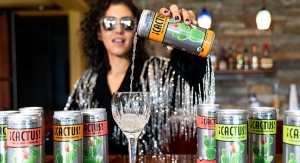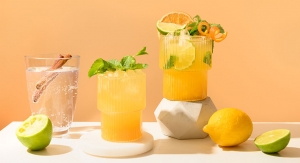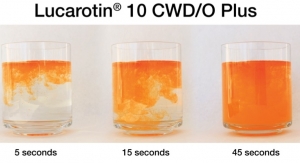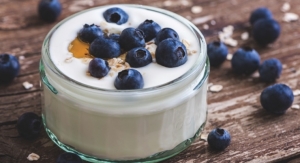In the world of functional foods and beverages, the success of a product relies just as heavily on appearance as it does flavor. Before a food or beverage ever reaches a consumer's mouth, he or she judges that product on its appearance, consciously or unconsciously. After all, humans are predominantly a visual species. For this reason, the colors industry represents an important class of ingredients working to enhance the appearance of the functional foods and beverages we eat and drink.
Discussing the role of colors was Yosuf Chaudhry, senior food scientist, GNT USA, Tarrytown, NY. "Color relays important information about flavor and promotes a sense of freshness, fullness and wholesomeness to food products," he explained.
Gail Stout, technical services manager-Colors, Chr. Hansen, Milwaukee, WI, said colors influence the perception of a product, such as its flavor, flavor intensity and overall quality, especially from a consumer's perspective. From the manufacturer's perspective, she said, colors provide consistency in cases where natural variation exists. In addition, they can be used to replace or enhance coloration that was lost during processing.
In the mainstream food and beverage category, it has always been understood that an attractive appearance is a very important attribute for attracting consumer interest, according to Rodger Williams, director of new business development, Polyphenolics, Inc., Granger, IL. "This seems to hold true with nutraceutical foods as well as beverages," he said.
Naturally Speaking�
The dominant trend in the colors market indicates that more consumers prefer natural food and beverage colors as opposed to their synthetic counterparts. The natural concept is inherent to the nature of functional foods and beverages. "People don't want to buy functional food or beverage products that contain synthetic colors because it defeats the whole idea of functional foods," commented Ginny Bank, technical director, RFI Ingredients, Blauvelt, NY.
Polyphenolics' Mr. Williams concurred. "Health food consumers have always preferred natural products and ingredients, colors included. This is because the word natural conveys a sense of wholesomeness and goodness," he said.
Chr. Hansen's Ms. Stout said natural colors extracted from fruits and vegetables are a good fit for functional foods, which strive for clean labeling. "Consumers are becoming increasingly aware of the importance of eating colorful fruits and vegetables," she said. "Terms like anthocyanins, carotenoids, phytonutrients and phytochemicals are becoming more common in general literature, so products colored with vegetable or fruit juice are well received."
As a result of increased consumer demand for natural colors, companies are using only natural colors where possible. One major reason for this shift in attitude is that the safety of synthetic colors has come into question over the past several years. According to RFI's Ms. Bank, the number of astute label readers is growing and most of these people are parents concerned about the safety of their children. "More and more consumers are becoming aware of the differences between natural and synthetic colors," she said. "There are so many different chronic conditions, such as asthma, allergies and attention deficit disorder (ADD), which kids are contracting that are being linked to their diet." As a result, she said, label scrutiny will become even more of a trend as increasing evidence draws further connections between such conditions and synthetics.
However, while natural colors are perceived as ideal in the industry, the reality is that synthetics do offer advantages in both cost and functionality. As a result, synthetics are not likely to be replaced entirely anytime in the near future. According to Ms. Stout, "Both natural and synthetic colorants are proving popular," she said. "Colorants derived from natural sources tend to be preferred as a first choice because they fit the 'good for you' healthy image functional foods and beverages promote. However, a lot of factors come into play when developing a product, such as target market, desired color shade, product shelf life requirements and cost."
Discussing the issue of cost was RFI's Ellen Schutt, director of marketing. "Natural colors are a lot more expensive than synthetic colors," she said. "A lot of the larger food companies that are looking to get into the functional food and beverage arena are concerned in a different way about margins than a small health food store manufacturer is, so they have a hard time using natural colors even though they would probably be their first choice."
Another reason natural colors have yet to penetrate the mainstream in the U.S. is because consumers are so used to synthetic colors, more so than European and Asian consumers. Ms. Stout commented, "U.S. consumers have not been as sensitive to the use of synthetic colors as consumers in other countries. The general public doesn't seem to object to synthetic colorant use."
Ms. Schutt added her thoughts from a European perspective. "Natural colors are much more prevalent outside the U.S., especially in European countries where there is a much higher level of awareness of natural colors," she said. "There's more demand for them because consumers are more health conscious and as a result are willing to pay more."
Donald Wilkes, president, Blue Pacific Flavors, City of Industry, CA, discussed the Asian market. "In Asia, natural colors are more widespread because the Japanese tend to be more geared toward health and wellness. Because of this the Japanese market is much more mature than the U.S. in the natural colors category," he said.
Color Issues
Colors are an essential part of the product development process in terms of matching the right color to the appropriate flavor, stability, ingredient interactions and regulatory status.
Commenting on the former was GNT's Mr. Chaudhry, who explained that colors guide our senses to flavors prior to food contact based on our previous experiences with food. As a result, he said, "It becomes critical to marry the right color with the right flavor you are trying to deliver to ensure that the consumer comes away with the best sensory experience. Leaving color out of the product development process or minimizing its importance can be the difference between success and failure."
There are a host of problems that face developers using natural colors in the creation of functional products. Stability is one such problem. Chr. Hansen's Ms. Stout explained, "As with conventional foods and beverages, stability during processing and storage conditions is important. In the specific case of functional food and beverage applications, stability to other ingredients or nutrients that fortify the product, such as vitamins and minerals, is also important."
According to RFI's Ms. Bank, natural colors are more suitable for some products more than others. "Natural colors fade a lot faster. They brown easier," she commented. "Basically you've got to have a product that doesn't have a long shelf life to make it work with natural colors. Beverages are particularly challenging because they are exposed to light and light is damaging to natural colors. Certain products are more conducive to natural colors, such as yogurts and smoothies, which have a short shelf life not because of the color, but because of the ingredients in them. Anything that doesn't have to be shelf stable for a year or two is going to be an easier market for natural colors."
Ms. Bank also discussed the issue of pH. "Natural colors are not very stable above a pH of 4," she explained. "At that level you are starting to push the limit, where as the synthetic range is basically below 7. In this sense, beverages are a good application for natural colors because beverages tend to be on the lower pH scale. Yogurt and ice cream tend to be higher, so therefore the stability of the colors isn't going to be as long, but again, natural colors work in these applications because these products don't have a long shelf life to start."
Certain problems arise when anthocyanins are used to color functional beverages. Polyphenolics' Mr. Williams explained that with calcium fortification, beverage pH tends to increase and anthocyanin pigments fade as pH increases.
Commenting on the combination of vitamin C and anthocyanins, Ms. Stout offered, "While a very low level of ascorbic acid can help stabilize the color, higher levels typically found in fortified beverages are harmful and result in anthocyanin degradation. Many products today are being fortified with vitamin C and the anthocyanins are not stable to vitamin C, resulting in a shorter shelf life of the product."
Ms. Bank added her thoughts on vitamin C. "Vitamin C reeks havoc on natural colors. If you have a beverage manufacturer coming out with a natural beverage and wants 100% vitamin C, they're already starting behind the curve because there already exists a stability problem with natural colors to begin with and then by adding vitamin C the stability problem gets even worse," she said.
However, the biggest issue with natural colors, according to Ms. Banks is not functionality, but regulatory status. "Unlike most other ingredients, in order for something to be considered a natural color it actually has to be approved as a natural color," she said. "This is one obstacle that keeps the market from expanding."
Blue Pacific's Mr. Wilkes agreed. "A lot of natural colors are restricted in the U.S. due to regulatory issues," he said. "Typically, if you have a non-GRAS (generally recognized as safe) color you're not going to be able to use it unless you go self-affirmed GRAS or you go through a food additive petition or through the general GRAS approval process. It is very difficult to introduce new colors when the regulatory hurdles are such that they are a major deterrent for a lot of companies."
Ms. Bank said although there are few natural colors out there, the market will continue to grow slowly. "There are a lot of limitations on getting approval for natural colors and that is going to keep the market from growing quickly. However, the market has grown slowly from its inception," she offered. "Even in the last few years there have been more and more products that are being made with natural colors, but it's not huge, explosive growth. The market is going to plod along, getting bigger and bigger as more people demand natural colors. I don't really see the market leveling off, nor do I see it dropping. I see it growing at a steady rate."
Features
True Colors
As naturals colors become more popular, companies are working to overcome cost hurdles, formulation challenges and regulatory issues in order to meet the demand.
Tim Wright04.01.03
Related Knowledge Center
Related Live From Shows
-

California Natural Color to Showcase Clean Label Color Solutions
The company will also showcase its functional grape seed extracts for blood pressure support, and celebrate its 30th anniversary.10.09.24
-
-
Flavors & Colors | Natural/Organic

California Natural Color to Display Range of Natural Food and Beverage Solutions
Ingredient supplier showcases new shades of purple in its natural color palette.07.08.24
-
Breaking News | Delivery & Dosage Technologies | Proteins, Peptides, Amino Acids | Supplier News
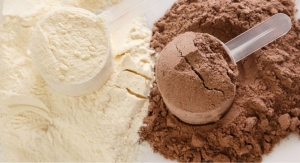
Farbest Brands Announces New Structural Changes and Investment Strategy
The company announced promotions and new investment strategies focused on proteins, hydrocolloids, and emulsifiers.04.11.23
-
Antioxidants | Breaking News | Cardiovascular Health | Dietary Supplements | Herbs & Botanicals | Natural/Organic | Supplier News
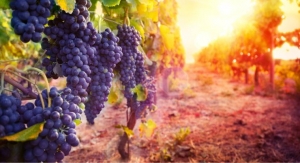
PLT to Market California Natural Colors’ MegaNatural Portfolio
The portfolio includes antioxidant and cardiovascular support ingredients sourced from grapes.11.21.22


